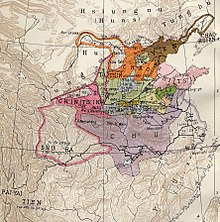Chu (state)
Chu ( Chinese 楚 , Pinyin Chǔ , W.-G. Ch'u ) was a kingdom in what is now southern China during the Western Zhou Dynasty (1046 to 771 BC), the time of the spring and autumn annals (722 to 481 BC) and the Warring States Period (475 to 221 BC).
The country was originally known as Jing ( 荆 ) and subsequently as Jingchu ( 荆楚 ). The largest expansion was an extensive area, including that of what is now the provinces of Hunan , Hubei , Chongqing , Henan , and parts of Jiangsu . The capital of Chu was Ying .
Historical lore
As the first vassal of the Zhou kings, Prince Chu Wuwang (King Wu of Chu) succeeded in establishing himself permanently as king in 703/704 BC, making himself ruler of the ruling Zhou dynasty on an equal footing . The background to this was the location of the semi-autonomous land in the southernmost part of the Zhou dominion, which was never fully subjugated. Historians explain this self-exaltation with diplomatic difficulties, which the Zi (子, translated mostly as Vice Count) of Chu must have had with his southern neighbors. Leaders of those non-Chinese regions and tribes also called themselves kings. After the prince of Chu had been denied a due rank (such as that of a gong ) by the ruling Zhou for decades despite pleadings, the appointment of a king should be understood less as an act of rebellion against the Zhou kings than as an effort to defend himself To maintain the respect of the vassals and neighboring empires. For a long time Chu remained the only Chinese principality that was ruled by a ruler formally equal to the Zhou king, and soon claimed in many other political gestures the status of an independent state that was no longer a vassal of the Zhou. It was not until the Warring States Period that other powerful gongs dared to call themselves kings, beginning in the middle of the 6th century in the states of Wu and Yue .
The southern Chu has been a constant threat to the fragile allies around the Zhou courtyard of the north since the beginning of the spring and autumn annals. That is why Chu remained one of the most powerful states in China for a long time; the later King Zhuang (around the turn of the century 600 BC) is usually counted among the Five Hegemons and thus one of the guarantors of the maintenance of the feudal order of China during this time.
Chu became known for annexing his allies and vassals (mostly small to very small states in its peripheral areas) and in this way slowly expanding his direct sphere of rule. These included (all years before Christ): E (863), Quan (704), Luo (690), Shen and Xi (between 688 and 680), Deng (678), Huang (648), Dao (after 643), Jiang (623), Liao and Lù (622), Ruo (after 622), Yong (611), Shuliao (601), Sui (near 506), Shuyong (574), Lai (538), Xu (512), Chen (479), Cai (447), Qi (445), Ju (431), Pi (after 418), Zou , Yue (334) and Lu (249).
In 223, as part of the unification of the empire, Chu was one of the last Chinese states to be conquered by Qin .
Archaeological evidence
Archaeologically, it has been proven through analysis of grave design and grave goods that the state of Chu was around 600 BC. In the middle of the spring and autumn annals, its customs and culture were fully under the influence of the Zhou kings, while its leaders also claimed political sovereignty and equality with the Zhou. Whether the Chu rulers and their culture came from a local leadership or whether and under what circumstances they came from the Zhou empire in the north has not yet been established. The first capital, Danyang , has not yet been found either.
Individual evidence
- ↑ So the Shiji of Sima Qian ; after Falkenhausen in Volume 40, pp. 1692/1695
- ↑ a b Lothar von Falkenhausen (Ed. Michael Loewe , Edward L. Shaughnessy): The waning of the bronze age . In: The Cambridge History of Ancient China , Cambridge 1999. pp. 514-525. ISBN 978-0-521-47030-8 . Digitized

